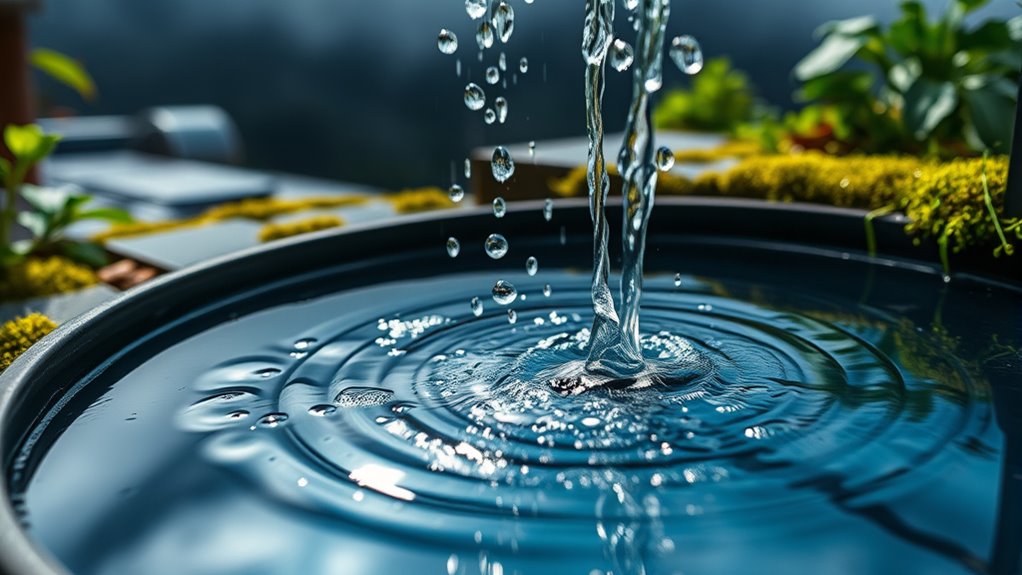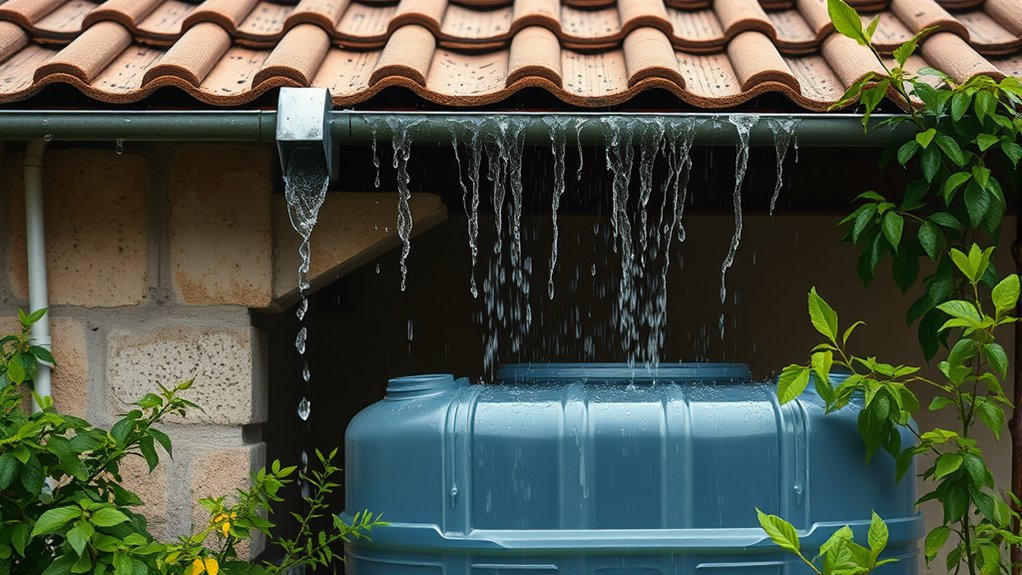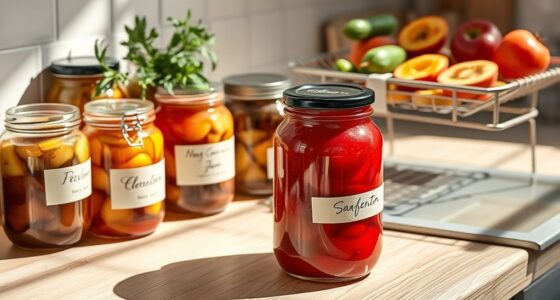You can turn rain into a valuable resource by setting up a simple system at home. Position a large container or barrel beneath your gutter downspouts to collect rainwater, which you can use for gardening, cleaning, or flushing toilets. Use lids and screens to keep out debris and pests, and regularly clean your system to maintain water quality. Properly managed, your rainwater harvesting setup helps save money and resources—discover more tips to improve your system as you continue.
Key Takeaways
- Install a collection system with barrels beneath gutters to capture rainwater for household use.
- Use lids, screens, and first-flush diverters to improve water quality and prevent debris or pests.
- Maintain the system regularly by checking for leaks, cleaning debris, and rinsing barrels to prevent algae and pests.
- Follow local regulations regarding rainwater harvesting to ensure compliance and optimize environmental benefits.
- Connect multiple containers and elevate them for increased storage capacity and efficient water access.

Have you ever wondered how something as simple as rain can become an essential resource? When you look up at the sky and see dark clouds gathering, it’s easy to overlook the potential this natural phenomenon holds. Rain isn’t just water falling from the sky; it’s an abundant, free source of life-sustaining liquid that can be harnessed right at home. Instead of letting rainwater run off your roof and into the drain, you can capture it, turning a fleeting moment into a lasting resource. Setting up a basic rain harvesting system involves placing a large container or barrel beneath your gutter downspout. When it rains, water flows from your roof into your collection container, providing you with a supply you can use for gardening, cleaning, or even flushing toilets. This simple system reduces your dependence on municipal water and helps conserve the environment.
To make the most of your rainwater collection, you should guarantee the system is properly secured and covered. A lid or screen on top of your barrel prevents debris, insects, and mosquitoes from breeding inside. It’s also important to position your container on a stable, elevated surface to facilitate easy access and prevent tipping. Connecting multiple barrels in series can increase your storage capacity, especially during heavy rain seasons. Additionally, installing a first-flush diverter can help improve water quality by diverting the initial, more contaminated flow of rainwater away from your storage tanks. This way, you’re collecting cleaner water that’s safer for your garden and household chores. Proper maintenance and cleaning of your system will ensure it remains effective over time, preventing algae and pest growth.
Storing rainwater at home isn’t just about capturing it; proper maintenance is key to keeping your system working effectively over time. Regularly check for leaks, clean out debris, and rinse your barrels to prevent algae growth. If you plan to use the water for plants, consider installing a basic filtration system to remove dirt and pests. It’s also wise to be aware of local regulations regarding rainwater harvesting, as rules vary depending on your location. Some areas encourage it, seeing it as a sustainable practice, while others have restrictions. Educating yourself on these policies ensures you stay compliant and make the most of this eco-friendly resource.
Frequently Asked Questions
What Are the Legal Regulations for Rainwater Harvesting in My Area?
You should check local regulations before harvesting rainwater, as rules vary by area. Contact your city or county water authority or visit their website to find specific laws. Some places require permits, restrict collection methods, or have limitations on storage capacity. Staying compliant guarantees you avoid fines or legal issues. Always stay informed about your local regulations, as they can change and impact your rainwater harvesting plans.
How Do I Prevent Mosquito Breeding in My Water Storage?
Are mosquitoes invading your water storage? To prevent breeding, always keep containers covered with tight-fitting lids or mesh screens. Regularly clean and scrub the tanks to eliminate mosquito eggs, and add fish or larvicides if suitable. Do you realize that stagnant water is a perfect breeding ground? By maintaining cleanliness and using protective covers, you stop mosquitoes from breeding and keep your water safe and healthy.
What Types of Filters Are Best for Household Rainwater?
You should choose a multi-stage filter system for household rainwater. Start with a coarse filter or mesh to remove debris and leaves, then use a fine sediment filter to trap smaller particles. Activated carbon filters help eliminate odors and improve taste, while UV sterilizers can kill bacteria and viruses. Combining these filters guarantees clean, safe water for household use, protecting your health and extending your storage system’s lifespan.
How Often Should I Clean My Rainwater Collection System?
You should clean your rainwater collection system at least twice a year to keep it safe. But don’t wait until you notice a problem—regular cleaning prevents buildup of debris, algae, and bacteria that could contaminate your water. After heavy storms or when your system looks dirty, give it a thorough check. Staying vigilant now means your water stays pure and ready whenever you need it most.
Can Stored Rainwater Be Used for Drinking Without Treatment?
You should not use stored rainwater for drinking without proper treatment. While it might seem clean, it can contain bacteria, viruses, and contaminants from leaves, dirt, or animals. To safely drink it, you need to filter and disinfect the water thoroughly, such as boiling, chlorination, or using UV purifiers. Always test your water quality regularly to guarantee it’s safe before consuming.
Conclusion
Just like the wise ants in Aesop’s fables, you can gather and store rainwater wisely, turning nature’s gift into a sustainable resource. By harvesting rain at home, you’re not only safeguarding your water needs but also contributing to a healthier planet. Remember, small actions echo through time—transform your home into a fountain of abundance. Embrace this simple act, and let your efforts ripple outward, proving that even the smallest drop can make a mighty difference.










